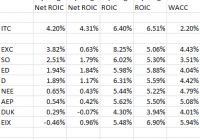Utilities Sector and Stocks Analysis from Seeking Alpha
Utilities Sector and Stocks Analysis from Seeking Alpha © seekingalpha.com. Use of this feed is limited to personal, non-commercial use and is governed by Seeking Alpha’s Terms of Use (http://seekingalpha.com/page/terms-of-use). Publishing this feed for public or commercial use and/or misrepresentation by a third party is prohibited. SeekingAlpha.com http://seekingalpha.com NRG Energy Is Ready For A Turnaround http://seekingalpha.com/article/3288025-nrg-energy-is-ready-for-a-turnaround?source=feed_sector_utilities 3288025 Sun, 28 Jun 2015 02:25:13 -0400 SCTY VSLR NRG Simple Investment Ideas PNM Resources: Potential Headwinds Diminish A Compelling Value Argument http://seekingalpha.com/article/3285845-pnm-resources-potential-headwinds-diminish-a-compelling-value-argument?source=feed_sector_utilities 3285845 Sat, 27 Jun 2015 08:45:43 -0400 PNM Tristan R. Brown Duke Energy: Dividend Increase Coming – What Investors Should Expect http://seekingalpha.com/article/3287375-duke-energy-dividend-increase-coming-what-investors-should-expect?source=feed_sector_utilities 3287375 Fri, 26 Jun 2015 19:40:14 -0400 DUK Bob Ciura Pepco-Exelon Merger: OPC-DC’s Position Raises Questions As To Agency’s Effectiveness, Relevancy http://seekingalpha.com/article/3287225-pepco-exelon-merger-opc-dcs-position-raises-questions-as-to-agencys-effectiveness-relevancy?source=feed_sector_utilities 3287225 Fri, 26 Jun 2015 16:51:06 -0400 EXC POM Transcend Event Driven Research PPL Remains On Track Despite Spin-Off http://seekingalpha.com/article/3287185-ppl-remains-on-track-despite-spin-off?source=feed_sector_utilities 3287185 Fri, 26 Jun 2015 16:35:55 -0400 TLN PPL Valuentum AES Corporation – A Long-Term Bet http://seekingalpha.com/article/3287175-aes-corporation-a-long-term-bet?source=feed_sector_utilities 3287175 Fri, 26 Jun 2015 16:34:41 -0400 AES Himanshu Gupta Xcel Energy Is Entering A Bear Cycle http://seekingalpha.com/article/3287135-xcel-energy-is-entering-a-bear-cycle?source=feed_sector_utilities 3287135 Fri, 26 Jun 2015 16:05:09 -0400 XEL Calder H. Lamb NiSource Is Overvalued And Speculative http://seekingalpha.com/article/3286025-nisource-is-overvalued-and-speculative?source=feed_sector_utilities 3286025 Fri, 26 Jun 2015 09:24:36 -0400 NI Benjamin Clark DTE Energy: Bearish Sentiment And Solid Earnings Potential Make This Utility Look Undervalued http://seekingalpha.com/article/3283005-dte-energy-bearish-sentiment-and-solid-earnings-potential-make-this-utility-look-undervalued?source=feed_sector_utilities 3283005 Fri, 26 Jun 2015 08:04:21 -0400 DTE Tristan R. Brown What’s The Matter With Utilities Stocks? http://seekingalpha.com/article/3284665-whats-the-matter-with-utilities-stocks?source=feed_sector_utilities 3284665 Thu, 25 Jun 2015 16:18:21 -0400 XLU Adam Freedman Duke Energy – Repositioning Business http://seekingalpha.com/article/3284365-duke-energy-repositioning-business?source=feed_sector_utilities 3284365 Thu, 25 Jun 2015 14:57:01 -0400 DUK Equity Watch Ameren Corporation: Creating Stable Income Streams At Less Risk Than The Market http://seekingalpha.com/article/3284145-ameren-corporation-creating-stable-income-streams-at-less-risk-than-the-market?source=feed_sector_utilities 3284145 Thu, 25 Jun 2015 14:33:48 -0400 AEE Calder H. Lamb Southern Co. And Exelon – ‘Why Don’t You Try Me’ http://seekingalpha.com/article/3283915-southern-co-and-exelon-why-dont-you-try-me?source=feed_sector_utilities 3283915 Thu, 25 Jun 2015 13:35:02 -0400 EXC SO George Fisher German Government Provides Relief For RWE- But That Won’t Turn The Share Price http://seekingalpha.com/article/3283305-german-government-provides-relief-for-rwe-but-that-wont-turn-the-share-price?source=feed_sector_utilities 3283305 Thu, 25 Jun 2015 09:37:42 -0400 EONGY RWEOY Catharina Hillenbrand-Saponar Brookfield Infrastructure Partners: World Class Infrastructure Assets And Undervalued With Solid Growth Prospects http://seekingalpha.com/article/3283105-brookfield-infrastructure-partners-world-class-infrastructure-assets-and-undervalued-with-solid-growth-prospects?source=feed_sector_utilities 3283105 Thu, 25 Jun 2015 08:35:20 -0400 BAM BIP Caiman Valores Warm Weather In Q1 Didn’t Diminish Portland General Electric’s Long-Term Outlook http://seekingalpha.com/article/3278635-warm-weather-in-q1-didnt-diminish-portland-general-electrics-long-term-outlook?source=feed_sector_utilities 3278635 Wed, 24 Jun 2015 14:39:04 -0400 POR Tristan R. Brown NRG Could Be The Green Victim Of Green Energy http://seekingalpha.com/article/3275575-nrg-could-be-the-green-victim-of-green-energy?source=feed_sector_utilities 3275575 Tue, 23 Jun 2015 16:03:51 -0400 ENB NEE NRG Dana Blankenhorn In A Rising Natural Gas Market Dynegy Is Worth Considering http://seekingalpha.com/article/3278015-in-a-rising-natural-gas-market-dynegy-is-worth-considering?source=feed_sector_utilities 3278015 Tue, 23 Jun 2015 11:28:50 -0400 DYN Calder H. Lamb Growth And Upside Potential Highlight American Electric Power’s Bullish Credentials Going Forward http://seekingalpha.com/article/3277855-growth-and-upside-potential-highlight-american-electric-powers-bullish-credentials-going-forward?source=feed_sector_utilities 3277855 Tue, 23 Jun 2015 10:58:36 -0400 AEP Equity Watch Wisconsin Energy’s 3.93% Yield: A 5-Year High http://seekingalpha.com/article/3273675-wisconsin-energys-3_93-percent-yield-a-5-year-high?source=feed_sector_utilities 3273675 Tue, 23 Jun 2015 04:31:32 -0400 TEG WEC Dividend Sleuth
